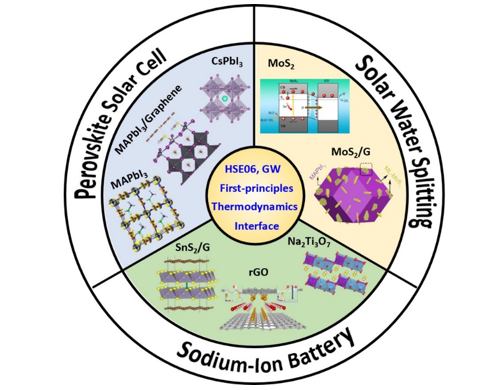Video Article Open Access
Advances in Design of New Energy Materials for Sustainable and Clean Energy Supply
Chol-Jun Yu1,*, Un-Gi Jong1,2, Song-Hyok Choe1,2, Kum-Chol Ri1, Jin-Song Kim1, Yun-Hyok Kye1,2, Song-Nam Hong1, Yong-Guk Choe1
1Computational Materials Science, Faculty of Materials Science, Kim Il Sung University, Pyongyang, PO Box 76, Democratic Peoples’ Republic of Korea
2Natural Science Centre, Kim Il Sung University, Pyongyang, PO Box 76, Democratic Peoples’ Republic of Korea
Vid. Proc. Adv. Mater., Volume 2, Article ID 2108217 (2021)
DOI: 10.5185/vpoam.2021.08217
Publication Date (Web): 17 May 2022
Copyright © IAAM
Graphical Abstract

Abstract
Nowadays, the issue of climate change and global warming is more often highlighted in the mass media as one of the most serious global challenges that human beings face [1]. During the past centuries, vast amounts of greenhouse gases including carbon dioxide and methane have been released into air by human activity of extensive burning fossil fuels such as coal, wood, oil and natural gas to run industry, operate buildings and drive transports. Such excessive mining and consumption of fossil fuels also cause the challenge for sufficient energy supplies. To mitigate the catastrophic effects of global warming and ensure sustainable energy supplies, more and more people and authorities are expressing a growing interest in renewable and clean energy sources, such that the majority of national and global energy policies include the exploitation of clean energy sources, such as solar energy, wind, hydraulic and tidal power. It is our ardent desire to develop innovative new functional energy materials, which make it possible for natural energy sources to become competitive with fossil fuels in the electricity market. In realizing our desire, we are applying the state-of-the-art first-principles methods to afford an insight into material properties and predict the shortest route for finding new functional materials, as atomistic modelling and simulation of materials have become an inevitable and powerful tool in materials development. We are focusing on halide perovskites as an energy harvesting material for a new type of perovskite solar cells (PSCs) [2,3], electrode materials for sodium-ion batteries (SIBs) [4,5], and photocatalysts for water-splitting hydrogen production. Although PSCs show rapid evolution of power conversion efficiency from 3.8% to over 25.5% during the past decade, the stability remains the critical problem due to the facile decomposition of methylammonium lead iodide perovskite (MAPbI3), which is the key material as a light absorber of PSCs. By applying the first-principles methods combined with thermodynamics for defects, we provide the atomistic mechanism behind the degradation of MAPbI3 under humid condition, presenting a strategy to overcome the negative effect of water on the performance and stability of halide perovskites [2,3]. The renewable and clean energy sources are often intermittent and thus require the advanced electrochemical energy storage systems with high efficiency, stability and reliability. With a merit of resource abundance of sodium on the Earth’s crust, SIBs are believed to meet the requirements of stationary energy storage and electric vehicles as the most promising candidate of lithium-ion batteries. We design the cathode and anode active materials using the layered metal oxides and sulphides complexed with graphene or graphene oxides to develop commercially viable SIBs. With these efforts, we believe that we contribute to the construction of efficient clean energy economy for sustainable and green world.
Keywords
Energy materials; perovskite solar cell; sodium-ion battery; water-splitting; hydrogen evolution.
Acknowledgement
The work was supported as part of the basic research project “Design of Innovative Functional Materials for Energy and Environmental Application” (no. 2016-20) by the State Commission of Science and Technology, DPR Korea. Computations have been done on the HP Blade System C7000 (HP BL460c) that is owned by Faculty of Materials Science, Kim Il Sung University.
References
- C.-J. Yu, Journal of Physics Energy, 2019, 1, 022001.
- Y.H. Kye, C.J. Yu, U.G. Jong, Y. Chen, A. Walsh, The Journal of Physical Chemistry Letters, 2018, 9, 2196-2201.
- U.G. Jong, C.J. Yu, Y.H. Kye, S.N. Hong, H.G. Kim, Physical Review Materials, 2020, 4, 075403.
- K.-C. Ri, C.-J. Yu, J.-S. Kim, S.-H. Choe, Inorganic Chemistry, 2019, 58, 1433-1441.
- C.-J. Yu, S.-G. Hwang, Y.-C. Pak, S.-H. Choe, J.-S. Kim, K.-C. Ri, The Journal of Physical Chemistry C, 2020, 124, 17897-17906.
Video Proceedings of Advanced Materials

Upcoming Congress



